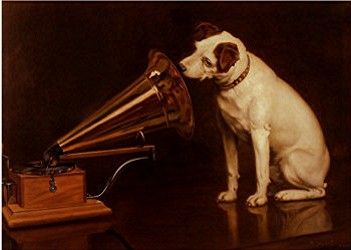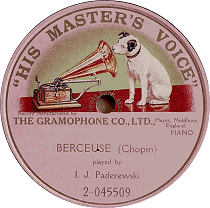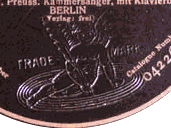"His
Master’s Voice" Trademark

In
February 1909 the Gramophone Company
finally replaced the "Recording
Angel" trademark used on labels
since as early as February 1899 with
the "His Master’s Voice" trademark
which William Barry Owen had purchased
from the painter Francis Barraud in
that same year, and which the Victor
Talking Machine Company had been using
as its trademark since January 1902.
The original painting is shown above.
It may be noted here that the Gramophone
Company had been using the HMV trademark
on its tins of gramophone needles since
as early as February 1904 (see the February
1904 Catalogue cover shown above). Moreover,
John Bennett states that the HMV trademark
had appeared on supplements as early
as January 1900.
HMV
record labels used during the acoustical
recording era fall into four major categories:
1) Gramophone Co., Ltd., with the Dog
trademark; 2) His Master's Voice, large
and small trademarks; 3) HMV B, C, D,
and E series; and 4) HMV DA, DB, and
other International Celebrity series.
Labels were printed in different colors
to identify price categories. In addition,
a dark green label was used for lesser
recording lights, for both 10- and 12-inch
discs, from as early as 1909 to 1921
or later. As noted above, Russian labels
never bore the HMV trademark.
During
the first period described above labels
with the same general format were used
in various countries in Europe, particularly
in Spain. The only words in English
on these labels were the designation
above the trademark, the language, the
vocal range or instrument and the accompaniment.
During this period the label showed
two catalog numbers placed at 5 and
7 o’clock on the label. This format
has been seen on issues as late as December
27, 1911. Sometime during this period
the double catalog numbers were replaced
by a single number, which continued
through about February 1918, when quadrants
were placed in the lower half of the
label (see below under Double-Sided
Issues)
From
February 1909 to August 1910 the HMV
label consisted of an unframed trademark
occupying most of the upper half of
the label, above which was the lettering
GRAMOPHONE CONCERT RECORD or
GRAMOPHONE MONARCH RECORD. Directly
beneath the trademark was the company
designation, as Manufactured by The
Gramophone Co., Ltd., (and Sister Companies).
These are generally known as HMV
Monarch or Dog Monarch for 12-inch discs
and as HMV Concert or Dog Concert for
10-inch discs, respectively. The lower
company designation was used in 1912.
|
|
|
|
Figure
IV.A.1.a. pink, large font
|
Figure
IV.A.1.a. pink, small font
|
The
following four labels were issued during
the early HMV period from February 1909
through August 1910, for both 10- and
12-inch recordings. At that time the
Angel still appeared in smaller form
on various label styles, generally
at the lower center of the label.
|
|
|
|
|
|
|
February
1909
|
August 1910
|

IV.B.1.a.
Feb 1908 – Dec 1909

IV.B.1.b.
early 1909 to 1917
Company
Name Variations
In August 1910 the designation HIS
MASTER’S VOICE appeared on both
10- and 12-inch records in an arc above
the unframed trademark. The new design
included the company designation under
the trademark, as Manufactured by
THE GRAMOPHONE CO., LTD., Hayes, Middlesex,
England, as seen in the foregoing
illustrations. The first HMV labels
introduced in December 1910 were black
or pink (Bennett called this color violet-red,
and it appeared so frequently), followed
two years later by the double-sided
"B" and "C" series
with plum labels. These are discussed
in greater detail below. They were followed
by the "D" and "E"
series, introduced in February 1918,
both with black labels. These were replaced
by red labels in October 1932, and continued
until the end of the 78 rpm recording
era, around 1950. The violet label was
apparently dropped after March 1920.
Plum may be defined as a dark purple
to deep reddish purple color.
|
|
|
|
December
27, 1911
|
February
13, 1912
|
|
|
|
|
February
7, 1908
|
January
19, 1912
|
|
|
|
|
IV.B.1.a.
pink
|
IV.B.1.a.
green
|
|
|
|
|
IV.B.1.a.yellow
|
III.G.2.b.
purple
|
His
Master’s Voice Labels 1909 – 1917
The designs for the new double-sided
series were used for all HMV labels
during each period, as outlined below
in Section V. of the Outline of Label
Varieties. When quadrants were
added in the lower left and lower right
areas of the label after February 1918,
the space between them was initially
empty, but during the period of their
use until September 1926, various company
logos in various formats were placed
there (see below)
